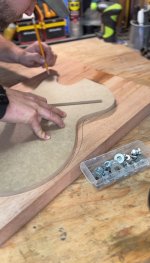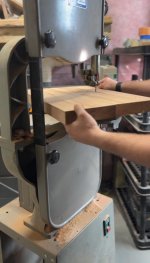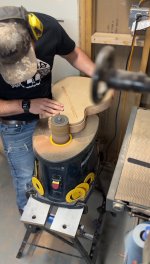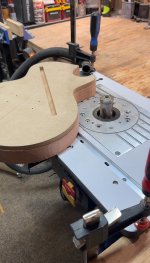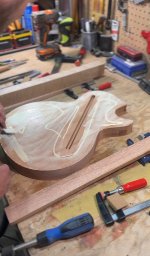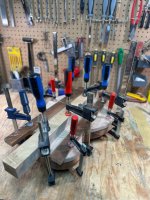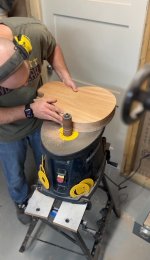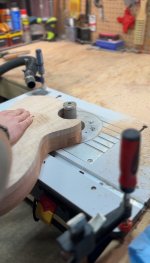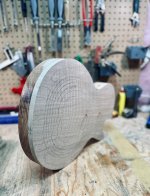vokeyz
Member
- Joined
- Aug 25, 2024
- Messages
- 34
- Reaction score
- 75
Hey everyone,
I’m excited to bring a long-form thread to life about this 59’ build I’ve attempted. I build and sell a small volume of T-style guitars but this is my first LP that I’ve ever built.
Post index:
Post#1: (Material assembly, intro) Below:
Post#2: Body blank glue up, Neck blank rough out
Post#1:
This “59” project came about from a conversation I once had with my Dad when I first started really getting serious about building guitars 3 years ago. He said one day he’d love to see me build a full Les Paul from scratch, and at that time it felt way out of reach. I'm fortunate that I grew up with his love of guitar influencing me to the point that I build my own now, and play regularly in an amateur capacity with lots of awesome people, including him when I can fly in. (Pictured here with his R8 and me with his old 80's Carvin)

Just before this last Christmas, my Dad retired and my mom and I had a covert conversation about what we were gonna do for his retirement gift/60th birthday. I told her I felt ready to ‘build’ him his “59” and we began putting the budget and timeline together. With a camping trip to British Columbia on the books to celebrate my dad’s first summer off (I’m based in Alberta and my family is in Quebec) the aim was to get this build done by then.
I started to do research, get templates, tools and jigs figured out. I began lurking here and reading through build threads to amass as much information I could along side the materials to build it. At the same time, doing my best to ask my dad critical questions about Les Pauls and his specific tastes without being obvious. We talk gear literally all the time so it was easy at first to inject it into conversation. I decided to get a pretty extensive template kit from Potvin Guitars for my template needs.

I sourced some African mahogany from my wood supplier, and began drafting out templates and deciding how to go about everything to leave maximum impact visually.

Initially, I was taking aim at building a Les Paul custom. My dad had talked about getting a custom in lieu of an R9, but over time I figured out his real, unbridled holy grail was a 59’ Reissue, not a custom. He’s a Les Paul/Gibson guy, so I opted to change course and go all the way. I recognize a 2-piece blank isn’t historic spec, but decided to make do regardless. There will be more than one thing that’s “not quite” historic, but I’m ok with that. Unglued, freshly joined body blank:

Some ebony banks I was toying with from my inventory:

I sourced this 2" slab of figured “AA” eastern hard maple from a local exotic wood supplier, thinking it would be a more accurate representation of a vintage top, but I was wrong in that this top feels much more pronounced than the original late 50's tops I think. More on this later.

Early on, with the custom being the goal I had sourced some ebony for the fretboard, but with the build pivot I ended up with Indian rosewood. As hard as I tried, it simply didn’t make sense here in Canada to get ahold of Brazilian rosewood for the build.

Initially, I was going to mill the board myself, cut the frets and radius the board, the entire gambit (as I do with all my builds). My local and long-distance supplier were out for months- so I did order this as a “part” from stewmac, as much as would have liked to do it all myself like my other builds.

For now, that’s the end of post one…more to come!
I’m excited to bring a long-form thread to life about this 59’ build I’ve attempted. I build and sell a small volume of T-style guitars but this is my first LP that I’ve ever built.
Post index:
Post#1: (Material assembly, intro) Below:
Post#2: Body blank glue up, Neck blank rough out
Post#1:
This “59” project came about from a conversation I once had with my Dad when I first started really getting serious about building guitars 3 years ago. He said one day he’d love to see me build a full Les Paul from scratch, and at that time it felt way out of reach. I'm fortunate that I grew up with his love of guitar influencing me to the point that I build my own now, and play regularly in an amateur capacity with lots of awesome people, including him when I can fly in. (Pictured here with his R8 and me with his old 80's Carvin)
Just before this last Christmas, my Dad retired and my mom and I had a covert conversation about what we were gonna do for his retirement gift/60th birthday. I told her I felt ready to ‘build’ him his “59” and we began putting the budget and timeline together. With a camping trip to British Columbia on the books to celebrate my dad’s first summer off (I’m based in Alberta and my family is in Quebec) the aim was to get this build done by then.
I started to do research, get templates, tools and jigs figured out. I began lurking here and reading through build threads to amass as much information I could along side the materials to build it. At the same time, doing my best to ask my dad critical questions about Les Pauls and his specific tastes without being obvious. We talk gear literally all the time so it was easy at first to inject it into conversation. I decided to get a pretty extensive template kit from Potvin Guitars for my template needs.
I sourced some African mahogany from my wood supplier, and began drafting out templates and deciding how to go about everything to leave maximum impact visually.
Initially, I was taking aim at building a Les Paul custom. My dad had talked about getting a custom in lieu of an R9, but over time I figured out his real, unbridled holy grail was a 59’ Reissue, not a custom. He’s a Les Paul/Gibson guy, so I opted to change course and go all the way. I recognize a 2-piece blank isn’t historic spec, but decided to make do regardless. There will be more than one thing that’s “not quite” historic, but I’m ok with that. Unglued, freshly joined body blank:
Some ebony banks I was toying with from my inventory:
I sourced this 2" slab of figured “AA” eastern hard maple from a local exotic wood supplier, thinking it would be a more accurate representation of a vintage top, but I was wrong in that this top feels much more pronounced than the original late 50's tops I think. More on this later.
Early on, with the custom being the goal I had sourced some ebony for the fretboard, but with the build pivot I ended up with Indian rosewood. As hard as I tried, it simply didn’t make sense here in Canada to get ahold of Brazilian rosewood for the build.
Initially, I was going to mill the board myself, cut the frets and radius the board, the entire gambit (as I do with all my builds). My local and long-distance supplier were out for months- so I did order this as a “part” from stewmac, as much as would have liked to do it all myself like my other builds.
For now, that’s the end of post one…more to come!
